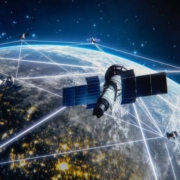SpaceX Starlink: Revolutionizing Internet with Satellite Technology
Access to fast and reliable internet has become essential in the modern world, yet billions of people still live in areas where stable connectivity is a challenge. Rural regions, remote islands, and underserved communities often face difficulties due to the lack of infrastructure. This is where SpaceX Starlink, a groundbreaking satellite internet project, is changing the game. By leveraging advanced technology and thousands of satellites, Starlink is making high-speed internet accessible across the globe.
What Is SpaceX Starlink?
SpaceX Starlink is an ambitious satellite internet constellation developed by SpaceX, the aerospace company founded by Elon Musk. Unlike traditional internet providers that rely on underground cables or geostationary satellites, Starlink uses thousands of low Earth orbit (LEO) satellites to deliver fast, low-latency internet.
The project’s main goal is to bridge the digital divide, providing connectivity to areas that lack reliable broadband access. With continuous expansion, SpaceX Starlink has already reached millions of users worldwide.
How Does SpaceX Starlink Work?
The SpaceX Starlink system works through a constellation of interconnected satellites orbiting between 340 km and 1,200 km from Earth. This proximity allows faster data transmission compared to older satellite systems.
Key components of the service include:
- LEO Satellites: Thousands of satellites form a mesh network to ensure wide coverage.
- User Terminal (Dish): Customers receive a small dish, nicknamed “Dishy,” that connects directly with the satellites.
- Ground Stations: Data is relayed between satellites and internet servers worldwide.
This infrastructure makes SpaceX Starlink accessible in regions where laying fiber-optic cables is too expensive or impossible.
Performance of SpaceX Starlink
One of the strongest features of SpaceX Starlink is its internet speed and stability:
- Download Speeds: Between 100 Mbps and 250 Mbps, with some users reporting speeds beyond 300 Mbps.
- Upload Speeds: Average between 20 Mbps and 50 Mbps, sufficient for video conferencing and cloud storage.
- Latency: Around 20–40 ms, far better than traditional satellite internet, which often suffers from latencies of 600 ms or more.
This level of performance makes SpaceX Starlink suitable for streaming, online gaming, remote work, and digital learning.
Why SpaceX Starlink Matters
The importance of SpaceX Starlink lies in its ability to make internet access universal. Benefits include:
- Global Accessibility – Reaching underserved communities in deserts, mountains, and remote islands.
- Disaster Relief – Providing emergency communication during natural disasters when ground networks fail.
- Digital Inclusion – Supporting education, healthcare, and e-commerce in regions without infrastructure.
- Support for Businesses – Remote industries like oil rigs, ships, and rural enterprises gain reliable connections.
By tackling these issues, SpaceX Starlink is shaping the future of digital connectivity.
Cost of SpaceX Starlink
The service requires both hardware and a subscription plan:
- Hardware Kit: Around $599, which includes the dish, router, and cables.
- Monthly Subscription: Typically $110–$120 for residential users.
- Business Plans: Premium services offering higher bandwidth range from $250 to $500 per month.
Although costs are higher than traditional broadband, the value lies in accessibility where other options simply don’t exist.
Comparing SpaceX Starlink with Other Internet Options
| Internet Type | Download Speed | Latency | Coverage Area |
| SpaceX Starlink | 100–250 Mbps | 20–40 ms | Global, urban & rural areas |
| Fiber Broadband | 300 Mbps–1 Gbps+ | 5–20 ms | Urban & semi-urban areas |
| 5G Mobile Broadband | 200 Mbps–1 Gbps+ | 10–30 ms | Limited to major cities |
| DSL | 10–100 Mbps | 30–60 ms | Common in urban areas |
| Traditional Satellite | 10–30 Mbps | 600+ ms | Remote regions only |
This comparison highlights how SpaceX Starlink provides a balance of speed, latency, and accessibility unmatched by older satellite systems.
Challenges Facing SpaceX Starlink
Despite its success, SpaceX Starlink faces some obstacles:
- High Costs: Equipment and subscription fees may be unaffordable for some households.
- Weather Sensitivity: Heavy rain, snow, or sandstorms can reduce signal quality temporarily.
- Regulatory Barriers: Approval from local governments is required before rollout in each country.
- Space Debris Concerns: The deployment of thousands of satellites raises questions about orbital congestion.
Who Benefits from SpaceX Starlink?
The service is designed for diverse user groups, including:
- Rural Families: Those without access to fiber or DSL.
- Remote Workers: Professionals who need stable internet for video calls and online collaboration.
- Travelers: With portable kits, RV and boat owners can stay connected.
- Educational Institutions: Schools in underserved regions can access digital learning tools.
- Governments & NGOs: Disaster response teams and humanitarian missions can rely on SpaceX Starlink for critical communication.
The Future of SpaceX Starlink
Looking ahead, SpaceX Starlink aims to expand even further:
- More Satellites: Increasing the constellation will improve speed and reduce congestion.
- Advanced Technology: Laser interlinks between satellites will enhance global coverage.
- Affordable Pricing: Costs may decrease as adoption grows.
- Specialized Plans: Tailored services for businesses, aviation, and maritime industries are already in development.
The vision is to make SpaceX Starlink not just an alternative but a mainstream internet solution.
Conclusion
SpaceX Starlink represents a revolutionary step in the history of internet connectivity. By offering high-speed, low-latency access to even the most remote corners of the world, it addresses one of the greatest challenges of the digital age: equal access for all.
While costs, regulations, and environmental concerns remain, the progress so far proves that SpaceX Starlink is more than just a technology—it is a movement toward a truly connected planet. With continuous improvements and expanding coverage, it is set to play a defining role in the future of global communication.





Leave a Reply
Want to join the discussion?Feel free to contribute!